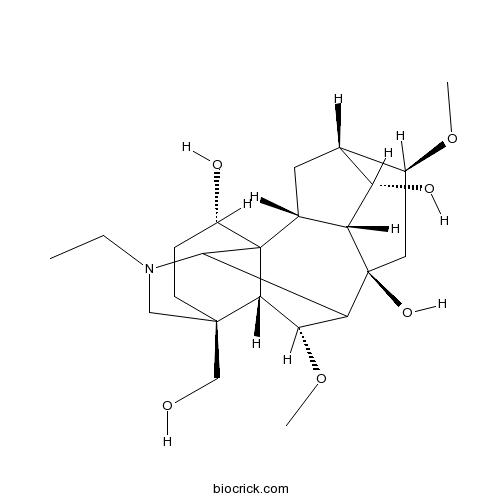NeolinineCAS# 112515-37-4 |

Quality Control & MSDS
3D structure
Package In Stock
Number of papers citing our products

| Cas No. | 112515-37-4 | SDF | Download SDF |
| PubChem ID | 137346018 | Appearance | Powder |
| Formula | C23H37NO6 | M.Wt | 423.6 |
| Type of Compound | Alkaloids | Storage | Desiccate at -20°C |
| Solubility | Soluble in Chloroform,Dichloromethane,Ethyl Acetate,DMSO,Acetone,etc. | ||
| Chemical Name | (2R,3R,4S,5S,6S,8R,13S,16S,17R,18R)-11-ethyl-13-(hydroxymethyl)-6,18-dimethoxy-11-azahexacyclo[7.7.2.12,5.01,10.03,8.013,17]nonadecane-4,8,16-triol | ||
| SMILES | CCN1CC2(CCC(C34C2C(C(C31)C5(CC(C6CC4C5C6O)OC)O)OC)O)CO | ||
| Standard InChIKey | RQCXQGUVPFYJCE-LDIBJOKXSA-N | ||
| Standard InChI | InChI=1S/C23H37NO6/c1-4-24-9-21(10-25)6-5-14(26)23-12-7-11-13(29-2)8-22(28,15(12)17(11)27)16(20(23)24)18(30-3)19(21)23/h11-20,25-28H,4-10H2,1-3H3/t11-,12-,13+,14+,15-,16?,17+,18+,19-,20?,21+,22-,23?/m1/s1 | ||
| General tips | For obtaining a higher solubility , please warm the tube at 37 ℃ and shake it in the ultrasonic bath for a while.Stock solution can be stored below -20℃ for several months. We recommend that you prepare and use the solution on the same day. However, if the test schedule requires, the stock solutions can be prepared in advance, and the stock solution must be sealed and stored below -20℃. In general, the stock solution can be kept for several months. Before use, we recommend that you leave the vial at room temperature for at least an hour before opening it. |
||
| About Packaging | 1. The packaging of the product may be reversed during transportation, cause the high purity compounds to adhere to the neck or cap of the vial.Take the vail out of its packaging and shake gently until the compounds fall to the bottom of the vial. 2. For liquid products, please centrifuge at 500xg to gather the liquid to the bottom of the vial. 3. Try to avoid loss or contamination during the experiment. |
||
| Shipping Condition | Packaging according to customer requirements(5mg, 10mg, 20mg and more). Ship via FedEx, DHL, UPS, EMS or other couriers with RT, or blue ice upon request. | ||
| Description | 1.Neolinine(at 10uM) shows significant hERG K+ channel inhibition activity. |
| Targets | Potassium Channel |

Neolinine Dilution Calculator

Neolinine Molarity Calculator
| 1 mg | 5 mg | 10 mg | 20 mg | 25 mg | |
| 1 mM | 2.3607 mL | 11.8036 mL | 23.6072 mL | 47.2144 mL | 59.0179 mL |
| 5 mM | 0.4721 mL | 2.3607 mL | 4.7214 mL | 9.4429 mL | 11.8036 mL |
| 10 mM | 0.2361 mL | 1.1804 mL | 2.3607 mL | 4.7214 mL | 5.9018 mL |
| 50 mM | 0.0472 mL | 0.2361 mL | 0.4721 mL | 0.9443 mL | 1.1804 mL |
| 100 mM | 0.0236 mL | 0.118 mL | 0.2361 mL | 0.4721 mL | 0.5902 mL |
| * Note: If you are in the process of experiment, it's necessary to make the dilution ratios of the samples. The dilution data above is only for reference. Normally, it's can get a better solubility within lower of Concentrations. | |||||

Calcutta University

University of Minnesota

University of Maryland School of Medicine

University of Illinois at Chicago

The Ohio State University

University of Zurich

Harvard University

Colorado State University

Auburn University

Yale University

Worcester Polytechnic Institute

Washington State University

Stanford University

University of Leipzig

Universidade da Beira Interior

The Institute of Cancer Research

Heidelberg University

University of Amsterdam

University of Auckland

TsingHua University

The University of Michigan

Miami University

DRURY University

Jilin University

Fudan University

Wuhan University

Sun Yat-sen University

Universite de Paris

Deemed University

Auckland University

The University of Tokyo

Korea University
- Isoabsouline
Catalog No.:BCN1955
CAS No.:112513-34-5
- Absouline
Catalog No.:BCN1954
CAS No.:112513-33-4
- Picrasidine S
Catalog No.:BCN6006
CAS No.:112503-87-4
- Aristolactam FI
Catalog No.:BCN6005
CAS No.:112501-42-5
- 6-Aldehydo-isoophiopogonone A
Catalog No.:BCN6629
CAS No.:112500-90-0
- 5-Aminoisoquinoline
Catalog No.:BCC8736
CAS No.:1125-60-6
- 4,4-Pentamethylenepiperidine hydrochloride
Catalog No.:BCC6059
CAS No.:1125-01-5
- H-Glu(OcHex)-OH
Catalog No.:BCC2929
CAS No.:112471-82-6
- U-54494A hydrochloride
Catalog No.:BCC6668
CAS No.:112465-94-8
- 3-Phenyl-1-(pyrrol-1-yl)propan-1-one
Catalog No.:BCN4005
CAS No.:112448-69-8
- AZ3146
Catalog No.:BCC3731
CAS No.:1124329-14-1
- Ganoderic acid Jb
Catalog No.:BCN7972
CAS No.:112430-68-9
- Tubuloside A
Catalog No.:BCN2806
CAS No.:112516-05-9
- Citrusinol
Catalog No.:BCN8083
CAS No.:112516-43-5
- CI994 (Tacedinaline)
Catalog No.:BCC2159
CAS No.:112522-64-2
- ent-16alpha,17-Dihydroxyatisan-3-one
Catalog No.:BCN6607
CAS No.:112523-91-8
- Pioglitazone HCl
Catalog No.:BCC2278
CAS No.:112529-15-4
- 4-O-Methylepisappanol
Catalog No.:BCN3674
CAS No.:112529-37-0
- Mps1-IN-1
Catalog No.:BCC5590
CAS No.:1125593-20-5
- A 804598
Catalog No.:BCC6198
CAS No.:1125758-85-1
- SKLB610
Catalog No.:BCC3647
CAS No.:1125780-41-7
- 4-Allylpyrocatechol
Catalog No.:BCN6009
CAS No.:1126-61-0
- Iso-mogroside V
Catalog No.:BCN3047
CAS No.:1126032-65-2
- Dicyclanil
Catalog No.:BCC8938
CAS No.:112636-83-6
Diterpene alkaloids from Aconitum anthora and assessment of the hERG-inhibiting ability of Aconitum alkaloids.[Pubmed:20862641]
Planta Med. 2011 Mar;77(4):368-73.
A new norditerpene alkaloid, 10-hydroxy-8- O-methyltalatizamine (1), was isolated from the whole plant of ACONITUM ANTHORA L. besides the known isotalatizidine (2) and hetisinone (3). The structures were determined by means of HR-ESI-MS, 1D and 2D NMR spectroscopy, including (1)H-(1)H COSY, NOESY, HSQC and HMBC experiments, resulting in complete (1)H and (1)(3)C chemical shift assignments for 1- 3, and revision of some earlier (1)(3)C-NMR data. The effects of the isolated compounds, together with twenty-one other ACONITUM alkaloids with different skeletal types and substitution patterns, on hERG channels were studied by the whole-cell patch clamp technique, using the QPatch-16 automated patch clamp system. At 10 microM, aconitine, 14-benzoylaconine 8- O-palmitate, songoramine, gigactonine and Neolinine demonstrated significant hERG K+ channel inhibition; all other compounds exerted only low (6-21%) inhibitory activity.


